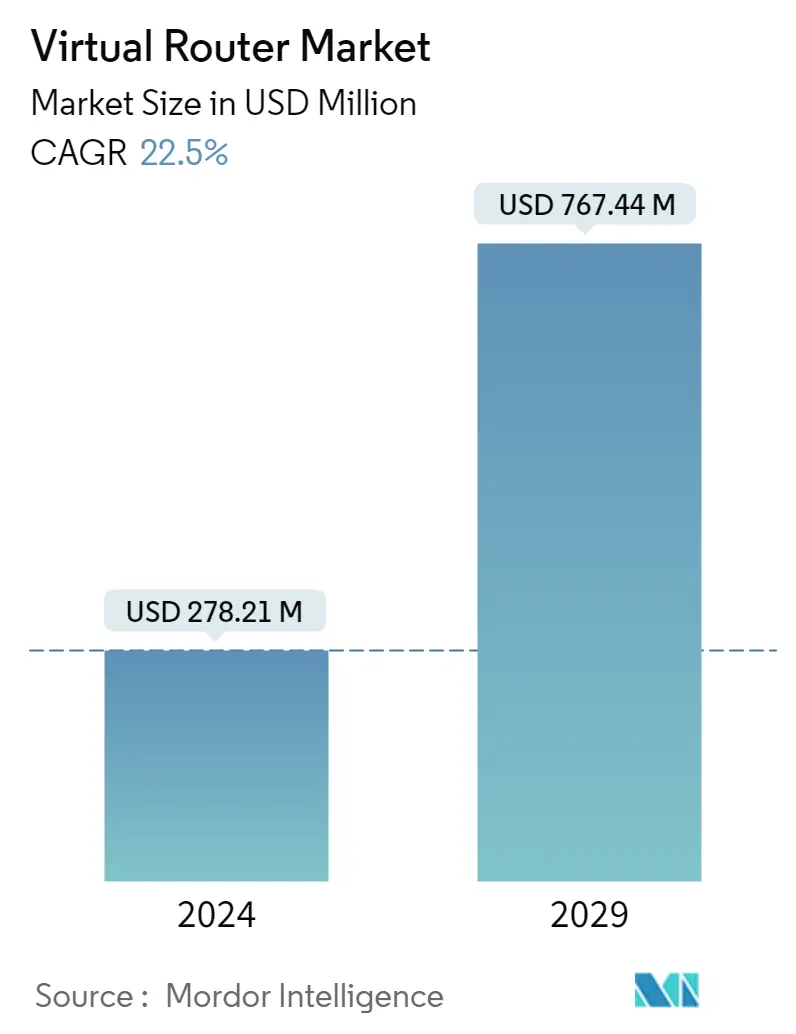Market Size of Virtual Router Industry

| Study Period | 2019 - 2029 |
| Market Size (2024) | USD 278.21 Million |
| Market Size (2029) | USD 767.44 Million |
| CAGR (2024 - 2029) | 22.50 % |
| Fastest Growing Market | Asia Pacific |
| Largest Market | North America |
Major Players
*Disclaimer: Major Players sorted in no particular order |
Need a report that reflects how COVID-19 has impacted this market and its growth?
Virtual Router Market Analysis
The Virtual Router Market size is estimated at USD 278.21 million in 2024, and is expected to reach USD 767.44 million by 2029, growing at a CAGR of 22.5% during the forecast period (2024-2029).
The virtual router market is driven by the increasing demand from the telecommunication and enterprise sector as service providers are increasingly moving from expensive, dedicated hardware devices to virtualized solutions that reduce the total cost of ownership (TCO), flexibility, and scalability.
- The increasing focus on software-defined networking (SDN) has led to the development of several advanced virtual router software solutions. Moreover, the growing demand for private cloud and virtual router applications across network segments in the telecommunication and enterprise sector is expected to provide significant growth opportunities in the market.
- Further, in the past few years, enterprise services have been becoming more diversified; more and more enterprises have deployed virtual private clouds (VPCs) on public or private clouds to cloudification and virtualize enterprise networks and IT infrastructure, thereby reducing network costs and implementing fast service rollout. Such factors increase the demand for cost-effective solutions such as Virtual routers in end-user segments owing to their scalability and cost-effective features.
- Additionally, as cloud-based services develop, applications and traffic surge rapidly. Traditional enterprise WANs face challenges in enterprise infrastructure and service cloudification requirements. Virtual routers cope with trends of network device cloudification and virtualization. In addition, virtual routers save hardware costs because no dedicated hardware platform is required. Such developments resulted in virtual routers gaining significant traction in the past few years, expanding the virtual router market.
- Moreover, the rising need for private clouds in enterprises coupled with expanding popularity of cloud services is creating growth opportunities for the market over the forecast period. These cloud services are strengthening their operations via the deployment of virtual routers, consequently fostering market growth. The need for virtual routers has significantly increased in the network environment due to their favorable features, which include faster data acquisition, faster network speed increases, and safer storage networks, among others, for cloud services.
- Most industries faced difficulties as a result of the COVID-19 pandemic. Governments across the world forced indefinite shutdowns and disrupted supply chains. Businesses attempted to reduce maintenance costs across network environments, thus increasing the demand for virtual routers to reduce the total cost of ownership. Moreover, the market is expected to witness significant demand post-pandemic owing to the high penetration of digitization and cloud services and innovations in the virtual router environment.
